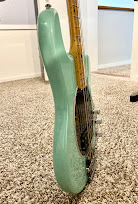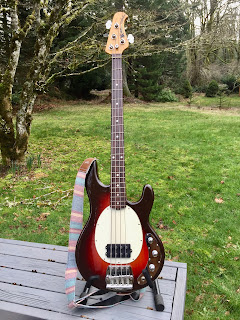 Since the last entry, I've streamlined my bass collection down to the bare essentials while in the process covering several sonic and intangible desires.
Since the last entry, I've streamlined my bass collection down to the bare essentials while in the process covering several sonic and intangible desires. Sonically, the traditional core vintage tones are covered via my G&L L2000 with its "K-wiring" which turns the humbuckers into single coils and provides me with the classic Fender tones of the mighty P and J basses. Those MFD pickups are monsters themselves; that one bass could honesty be all a person needs. More on that in a future post.
 With the traditional vintage tones covered, I focused on my favorite tones-- those of the Stingray Bass. Along with the sonic characteristics, the Stingray also satisfies many intangibles.
With the traditional vintage tones covered, I focused on my favorite tones-- those of the Stingray Bass. Along with the sonic characteristics, the Stingray also satisfies many intangibles.So what's the deal with Stingray Basses and intangibles?
Every player searches for an instrument capable of expressing the music they hear within themselves. --Yes, I know that sounds corny, but it is what it is.-- The Stingray Bass is that instrument for me. Concerning the intangibles.
A Short History:
First, a little context. History of the Stingray Bass can be generalized in three eras:
1. Pre-Ernie Ball era
2. Ernie Ball 1985 --> (2 & 3 band EQ models) 2017ish
3. 2018 Stingray Special
 |
| L-R: Pre-Ernie Ball/ EB 1985-2000s/ 2018 Stingray Special |
A little further into the historical weeds, Leo Fender (under the "CLF" moniker) created the Stingray for Music Man in the mid/late 1970s, until there was a falling out between the two companies. Leo went his way and opened G&L with his old buddy George Fullerton. Shortly thereafter Ernie Ball purchased Music Man and continued Stingray production which evolved mildly over the next several decades.
In 2018 Ernie Ball heavily redesigned Stingray, calling it the Special (which I wrote about here). Sonically the new Special is capable of capturing all eras of Stingray tone. The feel however, is different. It feels modern, more comfortable and refined. And that is what makes the other models equally important, and why they remain in the Music Man catalog.
Pre-Ernie Ball: "Old Smoothie"
Pre-Ernie Ball: "Old Smoothie"
In a way, the Stingray began with Old Smoothie in the mid/late 1970s before Ernie Ball purchased Music Man. Old Smoothie was a prototype Leo built, then given to Sterling Ball for field testing. Sterling's bass was a funky chocolate sunburst, as was the first release of the 40th anniversary model. Subsequently Old Smoothie was only available in butterscotch and mint green.
A special pickup makes the 40th anniversary "Old Smoothie" unique because the strings to pass between pole pieces as did Fender's Precision & Jazz basses. A logical layout considering Old Smoothie was one prototype of the then soon to be released Stingray; an evolution of Leo Fender's earlier creations.
The unique pickup layout does produce a smoother tone. It's still a Stingray, just smoother sounding. The powered two-band EQ spices the flavor with volume/bass/treble, yet still has the warmth of a passive bass.
What stands out to me with Old Smoothie is the way the feel influences how I play it. The shape of its glossy neck, the small fret wire, its slab body... all contribute to how I interact with the instrument. And this is what I mean about intangible-- it has a personality and a vibe unique from other basses, even from other Stingrays. Smoothie didn't make it to production, but that which did-- the more aggressive sounding one-- was a big success for the small company.
"Stingray Classic" models were introduced in 2010. While similar to Smoothie in construction, the Classic represents later models produced under the Ernie Ball banner. With a slightly different 2-band EQ and period correct headstock logo, the main difference between the two is the pickups. Classic models come loaded with the traditional EB humbucker which is more aggressive than Smoothie and represents the sound most of us know as the Stingray.
This particular example from 2011 is a rare bird with a rosewood fingerboard and a chocolate sunburst finish Music Man called "retro-burst;" a finish very reminiscent to the first Old Smoothie, and available for only two years. Both models sport the classic slab body, figured maple necks, vintage type frets and most importantly from a players perspective-- modern appointments such as the wheel-type trussrod adjustment.
Intangible defined:
Something "unable to be touched or grasped; not having physical presence." While we are talking about basses that do have a physical presence, intangibles become subjective-- to the person playing the instrument. For me, these two basses feel like vintage models without having to fuss with the questionable dependability inherent with vintage instruments.
Having played many vintage instruments back when they were simply called "used" and "old," these new models actually do feel like the old ones and sound different than the modern basses. These weigh a bit more, are a little less comfortable as they don't have the belly & arm reliefs and surprisingly I do find myself wanting the third part of modern EQs-- the mid control- gasp!!. Those differences change the way I interact with the instrument compared to modern design basses. As such they force me to play differently that also reminds me of the old basses.
As I mentioned, intangibles will differ with each player who picks up the instrument. For me, these feel vintage; a younger player may not make those connections. Younger players lacking a life history with the original instruments should also still enjoy these modern classics as the fit and finish are top notch! It seems the attention to detail are a little more apparent than the standard basses leaving the factory.
A brave new world:
In 2018 Music Man released its updated flagship bass, the Stingray Special. In essence, the new Specials' are Stingrays for the modern day. For me, two updates stand above the rest: 1. The harshness of the Stingray's tone was tamed, 2. the bass is far more comfortable to play.
However, the Special is not the only Stingray to address that first point. For those who want a less-harsh sounding Ray, but prefer the classic styling and appointments of older models, Old Smoothie may be the answer.
Originally released wearing a two-tone sunburst finish in 2016 as its 40th anniversary model, Music Man decided to continue offering the model in subsequent years with two additional colors mentioned above. Aside from the color change and lack of the "40th" logo on the back of the headstock, it is the same bass.
What makes the new Stingray Special unique is the list of changes:
However, the Special is not the only Stingray to address that first point. For those who want a less-harsh sounding Ray, but prefer the classic styling and appointments of older models, Old Smoothie may be the answer.
Originally released wearing a two-tone sunburst finish in 2016 as its 40th anniversary model, Music Man decided to continue offering the model in subsequent years with two additional colors mentioned above. Aside from the color change and lack of the "40th" logo on the back of the headstock, it is the same bass.
What makes the new Stingray Special unique is the list of changes:
- New body contours
- 18V electronics
- Lightweight hardware
- Neodymium pickups
- Stainless steel frets
- Roasted maple neck
- Lightweight body woods
If I was limited to just one bass for the rest of my days, the Stingray Special is the one for me. It nails all the classic tones of the old models and thanks to the double humbuckers I can get a lot of additional great tones from the bass. Even though it lacks the intangibles associated with the other two models, this one has a vibe all its own-- and that aqua sparkle finish just slays me every time(!)
Including each of these models in the Music Man catalog provides us all with three fantastic flavors of Stingray tones-- more than enough to appeal to nearly every player considering a new instrument. Even more when you consider all the 5-string variants and recently a pair of short-scale Stingrays. Has there ever been a better time to be a bassist?
...Stay tuned & in tune!





